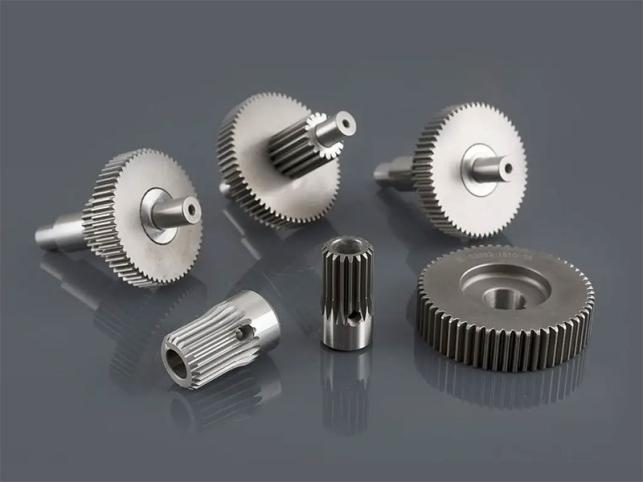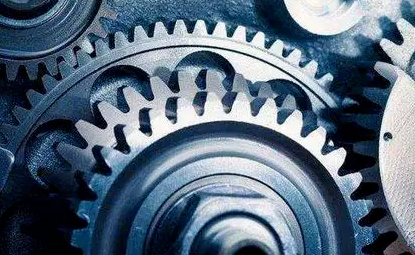Amid the hum of a car engine, transmission gears continuously rotate at high speeds of thousands of revolutions per minute. Like a team of meticulously coordinated mechanical dancers, they perform the complex "mechanical ballet" of power transmission through precise metal-to-metal meshing. Helical gears, with their unique spiral tooth structure, have become an indispensable core component of modern automotive transmissions. From the smooth shifting experience sought after in luxury sedans to the quiet driving environment demanded by electric vehicles, the customized design of helical gears is profoundly reshaping the driving experience.I. Helical Gears: Evolution from Noise Source to Silent CoreLimitations of Spur Gears: The "Source of Impact Noise" in the Gear WorldThe design of traditional spur gears resembles two interlaced combs, and tooth contact is instantaneous during meshing. This "rigid impact" contact generates intense shock loads and high-frequency vibrations, like a hammer striking iron, with each engagement accompanied by a piercing noise. In early automotive applications, the common "clicking" sound drivers experienced when shifting gears was a hallmark of spur gears.Furthermore, the extremely short contact line of spur gears concentrated the load on a small number of tooth flanks, causing a sharp increase in tooth pressure. This design not only accelerated gear wear but also significantly limited the transmission's load-carrying capacity. When vehicles needed to transmit high torque, the limitations of spur gears became apparent, making them incapable of meeting power transmission requirements.The Innovation of Helical Gears: "Progressive Engagement" of Helical TeethThe introduction of helical gears revolutionized this situation. Their teeth are arranged in a spiral pattern, forming a helix angle of 15° to 30° with the axis. When two helical gears mesh, the tooth contact exhibits a progressive characteristic, like the smooth interlocking of two spiral staircases, with the contact line gradually extending from the root to the tip of the tooth.This design offers three significant advantages:Quiet Operation: The extended contact line effectively disperses impact energy, reducing vibration frequency to a level imperceptible to the human ear. Test data shows that helical gear transmissions are 8-12 decibels quieter than spur gear versions, equivalent to reducing the noise level of a city road to the quietness of a library.Improved load-carrying capacity: With three to five tooth surfaces engaged simultaneously, load distribution is more even. Test results for a luxury brand's transmission show that helical gears have a 40% higher load capacity than spur gears, while also reducing wear by 60%.Extended service life: Uniform load distribution significantly reduces the risk of pitting and galling on the tooth surfaces. Customized helical gears using a special heat treatment process can achieve a service life exceeding three times that of spur gears.II. "Optimization Criteria" for Customized Helical Gears: Precision Control of Five Key ParametersCustomized helical gears are not simply replicas of standard parts; they require personalized design tailored to the specific vehicle model, powertrain, and driving scenario. This process is like a precise parameter optimization project, with even small adjustments to each parameter significantly impacting final performance.1. Helix Angle: The "Optimal Balance" of Speed and QuietnessThe helix angle is a key parameter in helical gear design. Increasing the helix angle lengthens the contact line, improving quietness and load-carrying capacity, but it also increases axial thrust, potentially leading to increased bearing wear. A sports car transmission uses a 28° helix angle design, ensuring track-level acceleration while keeping shift noise below 55 decibels (equivalent to the sound pressure level of a quiet conversation).2. Module and Number of Teeth: The Tradeoff Between Torque Transmission and Size OptimizationModule determines gear geometry, while the number of teeth influences transmission ratio characteristics. Electric vehicle transmissions, which must transmit instantaneous high torque, often employ large module designs (e.g., 3mm or greater). Hybrid vehicles, on the other hand, achieve finer ratio adjustment by increasing the number of teeth (e.g., 40 or more). A plug-in hybrid transmission achieved a 3% increase in motor efficiency and a 15 km increase in range by optimizing the module-tooth combination.3. Pressure Angle: The "Mechanical Balance" of Strength and EfficiencyThe standard pressure angle is 20°, but in aviation and heavy-duty applications, a 25° pressure angle is often used to enhance tooth root strength. By increasing the pressure angle from 20° to 22.5°, a heavy-duty truck transmission achieved a 25% increase in torque capacity while maintaining the same dimensions, while increasing friction loss by only 2%.4. Tooth Width: The "Hidden Support" of Structural StabilityTooth width directly affects the bending strength and thermal capacity of gears. High-performance transmissions often use a variable tooth width design—the input shaft gear is widened by 10% to handle greater torque, while the output shaft gear is narrowed to reduce weight. A supercar transmission uses this design to reduce weight by 15% while shortening the 0-100 km/h acceleration time by 0.3 seconds.5. Materials and Heat Treatment: "Performance Enhancement" of Metal MaterialsModern helical gears are commonly made of 20CrMnTi alloy steel. After carburizing and quenching, the surface hardness can reach HRC58-62, while the core hardness remains at HRC35-40. This "hard on the outside, tough on the inside" microstructure resists tooth wear and withstands impact loads. By optimizing the carburized layer depth (from 1.2mm to 1.5mm), a certain electric vehicle transmission has achieved a gear lifespan exceeding 500,000 kilometers, equivalent to 12 laps around the Earth.III. From Design to Finished Product: The "Manufacturing Process Chain" of Custom Helical GearsThe production of custom helical gears is a highly sophisticated process of "metal microstructure shaping," involving three core steps: material selection, processing technology, and quality control.1. Material Selection: "Performance Customization" of Metal MaterialsGear materials can be divided into three categories based on different operating conditions:Economical material: 45# steel, suitable for low-speed and light-load applications (such as agricultural vehicle transmissions).Performance material: 20CrMnTi, the mainstream choice for medium- and high-speed transmissions.Extreme operating material: 18Cr2Ni4WA, used in high-stress applications such as racing cars and heavy machinery.A German brand has improved gear fatigue resistance by 18% by adding 0.05% boron to 20CrMnTi, while increasing costs by only 3%.2. Processing Technology: Nano-level Precision "Mechanical Sculpting"Modern helical gear manufacturing utilizes a three-step process: hobbing, grinding, and honing.Hobbing: A hob is used to create a spiral tooth profile, achieving ISO Class 7 accuracy.Grinding: A diamond grinding wheel is used to precisely finish the tooth surface, achieving ISO Class 5 accuracy (within 0.008mm).Honding: A final polishing treatment using a honing wheel achieves a surface roughness of Ra < 0.2μm (equivalent to 1/500th the diameter of a human hair).A Japanese supplier has further reduced tooth surface roughness to Ra < 0.05μm (equivalent to 1/500th the diameter of a human hair) by introducing magnetorheological polishing technology, improving transmission efficiency by 0.8%.3. Quality Control: Microscopic Defect ScreeningEach custom helical gear undergoes over 200 rigorous inspections:3D scanning: Detects tooth profile errors within ±0.003mm.X-ray flaw detection: Finds internal defects as small as 0.01mm.Bench test verification: Simulates 10 years/300,000 kilometers of extreme operating conditions for durability testing.A domestic transmission company has increased its defect recognition rate from 92% to 99.97% by introducing an AI visual inspection system, reducing annual quality losses by over 10 million yuan.IV. The "Intelligent Upgrade" of Helical Gears
With the advancement of electrification and intelligent vehicles, helical gears are undergoing a new round of technological transformation:1. Electrification Adaptation: Lightweight and Efficient DesignElectric vehicles demand more compact, efficient, and quiet transmission designs. A new energy brand has developed a "hollow shaft helical gear" that reduces weight by 25% by hollowing out the shaft. A low-friction coating also improves transmission efficiency by 1.2%.2. Intelligent Manufacturing: The "Virtual Factory" of Digital TwinsBy creating a digital model of the gear, key performance indicators such as lifespan, noise, and transmission efficiency can be simulated during the design phase. A German supplier's digital twin system has shortened its new product development cycle from 18 months to 9 months and increased its first-time trial success rate from 65% to 92%.3. New Material Applications: Breakthroughs in Ceramics and Composite MaterialsIn the laboratory, silicon carbide ceramic gears have demonstrated remarkable potential—they weigh only one-third of steel gears and offer ten times greater wear resistance. A startup is developing steel-ceramic composite gears, aiming for mass production by 2030.Microscopic Gears, Outstanding PerformanceFrom the spur gear transmission of the Ford Model T to the single-speed reducer of the Tesla Model S, to the potential wireless transmission systems of the future, gears have always been a core component of power transmission. Helical gears, known as "silent experts" and "power optimizers" in this field, are constantly pushing the limits of physics through customized design.Next time you start your car, listen carefully—the nearly imperceptible hum of its rotation is the mechanical symphony of precision, strength, and beauty performed by hundreds of helical gears in the microscopic world of metal. Every note of this piece of music embodies the engineers' precise control of parameters and ultimate pursuit of manufacturing technology.




